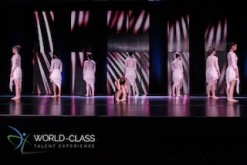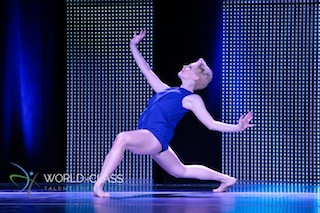Our guest, Shawna David is the Co-Founder and Executive Director of the dance competition organization, World-Class Talent Experience.
As we look toward the coming of a new competition season, it’s an issue deserving of a fresh look. We think you’ll appreciate Shawna’s unique perspective and balanced overview of the controversial issues that surround competition costume choices.
As a dance teacher, judge and competition director,

I have witnessed the “age-appropriateness” issue being discussed and fought over for some time, but most recently, the debate seems to have escalated, as costumes and styles have evolved. The issue has become a hot topic, resulting in serious and often emotional discussion, as sides are taken by studio directors, teachers and parents.
My background research for this article included telephone interviews with studio directors and dance parents. I also searched the internet for blogs and community boards that dealt with the topic. Finally, I went over photos from my competitions and my judges’ score sheets for the related performances.
By way of background, there are two “camps” of opinion on the matter. One group feels that costumes should not be restricted; the other fears that costumes are increasingly revealing and approach (or exceed) the point of being inappropriate, especially for younger dancers.
In this article, I will not take sides. I will instead try to provide in detail the arguments from both sides, and try to lay the groundwork for both sides to understand the reasoning behind the position each camp has taken.
Don’t shoot the messenger
When discussing this topic, I detect a great deal of hostility directed at dance competitions. Many parents (and some studio staff) have criticized our industry for not being more diligent in upholding standards in costume. Many parents have stated that the competition organizer should set strict dress guidelines and penalize (or even disqualify) any acts that fail to adhere to those guidelines. One parent went as far as to state that an offending act should be halted midstream.
On this topic, I will present my views. As the competition director, I must remain impartial. I have three independent judges who are well-aware of the issue. They will each rate the appropriateness of the costume based on their expert opinion. Like an umpire in a baseball game, their decision is final. They can deduct points for inappropriate music or costume as they see fit. As a policy, I will never try to influence or interfere with their decision on this or any other topic; the integrity of the judging process must be maintained.
Furthermore, I trust that the teacher, choreographer, parent and dancer will exercise good judgment in the selection of costume. Only under extreme conditions would I cancel a performance; and then only BEFORE the dancers take the stage.
Is the costume part of the performance?
There are many parents and teachers who are self-proclaimed “purists”, who believe that the dancer should be judged solely on the quality and technical precision of her movements, and that the costume should not be considered in adjudication. The most fanatical among them would like to see uniformity in costume (for example, every dancer must wear identical black leotards and tan tights). They feel that the judges should not be distracted by glitzy attire, and moreover that such uniformity would eliminate any unfair advantage a “rich” studio might have over others.
Opponents feel the costume is an essential and integral part of the performance. It complements the music and movements and makes the performance more exciting and interesting. Try to imagine The Nutcracker without the beautiful snowflakes costumes. They further state that in a dance competition, the performance as a whole is being judged, not just the dancers. The performance includes choreography, music selection, dance movements, scenery and props, and of course, costumes. A performance would not be complete if any one of those elements were missing. Competition dancers are serious performers, training to one day become professionals. How a dancer interacts with her costume is part of her training.

Location, Location, Location
Dance costumes often reflect the general sensibilities of the region. I have done competitions throughout the U.S. and I have found that generally, the costumes in Las Vegas are somewhat more glitzy (and racy) than the ones on the East coast. Community standards must be considered when judging the appropriateness of dress. In researching this article, I interviewed parents in various parts of the country. While my “poll” is not scientific, I get the feeling that the East coast is more conservative than the West coast. As a competition director, as a result of the good input I obtained, I intend to train my judges to be more attuned to the locale when considering costume and makeup.
Try to find middle ground
Everybody seems to have an opinion on this subject, but there is a small number whose views are extreme at opposite ends of the spectrum.
Those on the “left” feel strongly that the selection of costume (and all other things) should be completely in the hands of the creative team, and not be restricted in any way. They advocate total freedom of expression without regard to age, sex or any other factor.
Those on the “right” want nothing less than total control over the content of the performance, including costume, and have strong views regarding the propriety of costuming young dancers.
As with most things, a reasonable person will attempt to find “middle ground”; not to please everyone (that would be impossible) but to deal with the issue in a way that will offend the least number of people.
A reasonable approach
It seems to me that the driving force behind this controversy is the notion of “sexual connotation”- a topic that, though certainly not new even then, emerged in 2010 on Dance Advantage in Nichelle’s response to a controversial dance competition performance.
A six-year-old in a skimpy belly dancing costume is cute if she is performing a dance with “modest” movements. Add hip gyrations to that same scenario and most people will shout “inappropriate”. The music hasn’t changed. The costume hasn’t changed. The context has transformed the routine from an adorable little dance to something perverse.
Age is also a major factor. Most will agree that sexually explicit movements are inappropriate for a pre-teen dancer, but as the dancers’ age goes up, the same motions might be more acceptable. As a dancer’s age goes up, she is better equipped to make a decision as to what she is comfortable with.
The point is that costume must be considered in total context with the other elements of the routine, especially music and choreography.
Where do your opinions fall?
Tell us how you think about dance competition costumes in the comments!
Shawna David is the Co-Founder and Executive Director of World-Class Talent Experience. Prior to the launch of her dance competition organization, Shawna had an eminent career performing, teaching, judging and choreographing all over the world. Some professional performing highlights include “The Killers” Spaceman Music Video, Opening Gala for Natasha Bedingfield, Les Folies Bergere, Don Arden’s Jubilee, Premiere of Venetian Macau and Edinburgh Fringe Festival Scotland to name a few. Shawna is extremely dedicated and committed to offering a positive dance experience for young aspiring dancers. With a solid background in psychology, Shawna has designed a dance competition that supports growth, positivity, integrity and is a joy to be a part of! Her vision is to provide a wealth of opportunities that will enable dancers to reach the “next level” and attain the highest achievements. When Shawna is not traveling with WCTE, she is sharing her passion in the dance studio. For more of Shawna’s thoughts on enriching lives through dance, visit her blog dancechangeslives.wordpress.com.

Dance Advantage welcomes guest posts from other dance teachers, students, parents, professionals, or those knowledgeable in related fields. If you are interested in having your article published at Dance Advantage, please see the following info on submitting a guest post. Read posts from guest contributors.

